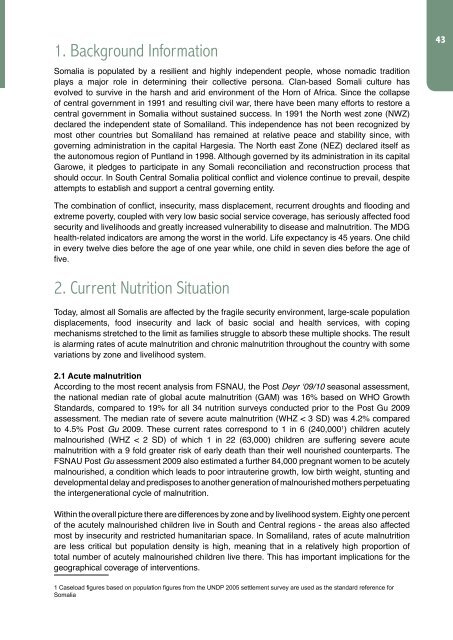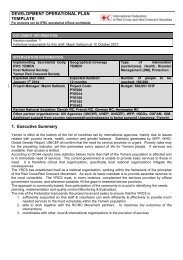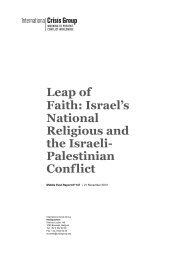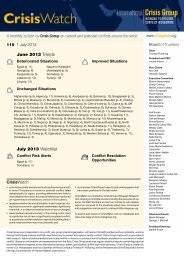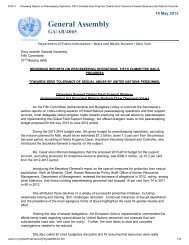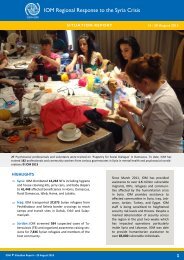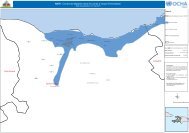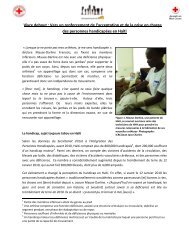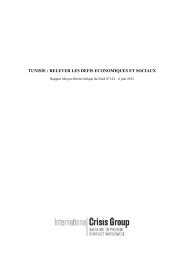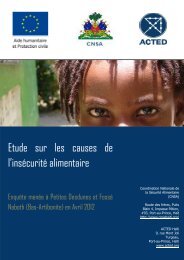SOMALI NUTRITION STRATEGY 2011 – 2013 - ReliefWeb
SOMALI NUTRITION STRATEGY 2011 – 2013 - ReliefWeb
SOMALI NUTRITION STRATEGY 2011 – 2013 - ReliefWeb
Create successful ePaper yourself
Turn your PDF publications into a flip-book with our unique Google optimized e-Paper software.
1. Background Information<br />
Somalia is populated by a resilient and highly independent people, whose nomadic tradition<br />
plays a major role in determining their collective persona. Clan-based Somali culture has<br />
evolved to survive in the harsh and arid environment of the Horn of Africa. Since the collapse<br />
of central government in 1991 and resulting civil war, there have been many efforts to restore a<br />
central government in Somalia without sustained success. In 1991 the North west zone (NWZ)<br />
declared the independent state of Somaliland. This independence has not been recognized by<br />
most other countries but Somaliland has remained at relative peace and stability since, with<br />
governing administration in the capital Hargesia. The North east Zone (NEZ) declared itself as<br />
the autonomous region of Puntland in 1998. Although governed by its administration in its capital<br />
Garowe, it pledges to participate in any Somali reconciliation and reconstruction process that<br />
should occur. In South Central Somalia political conflict and violence continue to prevail, despite<br />
attempts to establish and support a central governing entity.<br />
43<br />
The combination of conflict, insecurity, mass displacement, recurrent droughts and flooding and<br />
extreme poverty, coupled with very low basic social service coverage, has seriously affected food<br />
security and livelihoods and greatly increased vulnerability to disease and malnutrition. The MDG<br />
health-related indicators are among the worst in the world. Life expectancy is 45 years. One child<br />
in every twelve dies before the age of one year while, one child in seven dies before the age of<br />
five.<br />
2. Current Nutrition Situation<br />
Today, almost all Somalis are affected by the fragile security environment, large-scale population<br />
displacements, food insecurity and lack of basic social and health services, with coping<br />
mechanisms stretched to the limit as families struggle to absorb these multiple shocks. The result<br />
is alarming rates of acute malnutrition and chronic malnutrition throughout the country with some<br />
variations by zone and livelihood system.<br />
2.1 Acute malnutrition<br />
According to the most recent analysis from FSNAU, the Post Deyr ‘09/10 seasonal assessment,<br />
the national median rate of global acute malnutrition (GAM) was 16% based on WHO Growth<br />
Standards, compared to 19% for all 34 nutrition surveys conducted prior to the Post Gu 2009<br />
assessment. The median rate of severe acute malnutrition (WHZ < 3 SD) was 4.2% compared<br />
to 4.5% Post Gu 2009. These current rates correspond to 1 in 6 (240,000 1 ) children acutely<br />
malnourished (WHZ < 2 SD) of which 1 in 22 (63,000) children are suffering severe acute<br />
malnutrition with a 9 fold greater risk of early death than their well nourished counterparts. The<br />
FSNAU Post Gu assessment 2009 also estimated a further 84,000 pregnant women to be acutely<br />
malnourished, a condition which leads to poor intrauterine growth, low birth weight, stunting and<br />
developmental delay and predisposes to another generation of malnourished mothers perpetuating<br />
the intergenerational cycle of malnutrition.<br />
Within the overall picture there are differences by zone and by livelihood system. Eighty one percent<br />
of the acutely malnourished children live in South and Central regions - the areas also affected<br />
most by insecurity and restricted humanitarian space. In Somaliland, rates of acute malnutrition<br />
are less critical but population density is high, meaning that in a relatively high proportion of<br />
total number of acutely malnourished children live there. This has important implications for the<br />
geographical coverage of interventions.<br />
1 Caseload figures based on population figures from the UNDP 2005 settlement survey are used as the standard reference for<br />
Somalia


